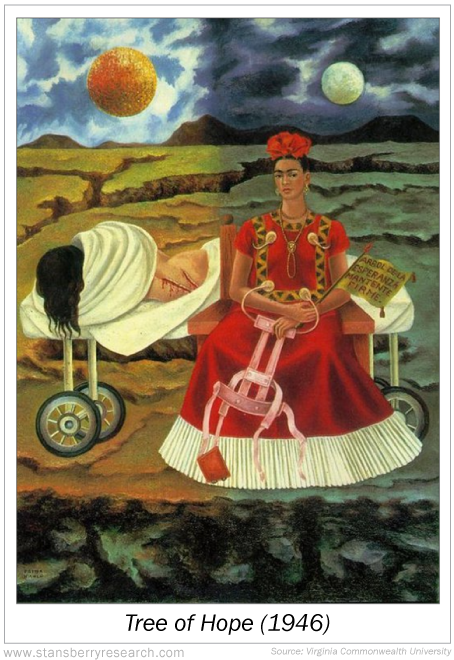On September 17, 1925, a bus and an electric trolley car collided in Mexico City...
Everyone inside the bus was injured, including 18-year-old Frida Kahlo, whose hip was impaled by a metal handrail, causing severe internal injuries.
After the accident, Kahlo spent several weeks recovering in Mexico City's Red Cross hospital. And when she returned home, she spent another three months in bed, wearing a full-body cast while she healed.
Kahlo's accident left her in tremendous pain – like lightning, she said – which persisted throughout her life.
And she coped with the pain by painting it...

Her parents first encouraged her to paint while she was bedridden and healing. They constructed a special easel for her that rested on her lap and mounted a mirror to the top of her bed's canopy so she could see her own face while painting.
Eventually, her love of painting inspired her to become an artist full time. Today, she's one of the most famous painters in the world.
While not everyone can paint like Kahlo, she had surprising reasons for her art. Despite the trauma from her injury and other personal issues throughout her life, Kahlo said, "I am happy to be alive as long as I can paint." She used painting to help her get through difficult times.
Kahlo understood what science hadn't yet proven...
Expressing yourself in creative ways keeps your brain healthy. And there's plenty of science backing that up...
Numerous studies have shown that creating art can benefit our health by doing things like:
- Reducing stress
- Reducing anxiety
- Improving mood
- Increasing self esteem
- Helping you focus
- Encouraging imagination
- Generating feelings of hope
- Allowing you to process complicated emotions
- Creating an enriching social environment
- Activating the reward centers in your brain
In one study, researchers at Drexel University wanted to see how creating art – i.e. visual self-expression – affected the reward system in our brains. So with the help of 26 participants – some who were artists and some who were not – the researchers asked folks to color, doodle, and draw while their brain activity was recorded.
The participants got to do each activity for three minutes, and in between activities they rested with their eyes closed for two minutes. The neural activity in the front part of their brains – known as the prefrontal cortex – was recorded using functional near-infrared spectroscopy ("fNIRS") the entire time.
The researchers found that doing each of the three creative activities activated the participants' prefrontal cortices and reward pathways significantly more than the resting condition. And the doodling condition was found to create the most activation of the three forms of art.
This all essentially means that making art (like coloring, doodling, or drawing) tells your brain that you're getting rewarded... which makes you feel happy and gives you pleasure.
There are so many different ways to create and enjoy art, so try out some different things and discover what you enjoy most. If art isn't your thing, maybe music, baking, or photography would suit you more. Here are a few ideas to help you get started:
- Beginner drawing instruction (8-minute video) – "The drawing exercise that changed my life"
- Beginner watercolor lesson (16-minute video) – "The very first watercolor lesson for beginners"
- Beginner flower arrangement tutorial (6-minute video) – "Flower arranging 101"
- Beginner building project (8-minute video) – "Making bird house from waste material"
- Beginner harmonica lesson (8-minute video) – "Breathing and tone"
- Beginner baking instruction (12-video series, each is 6 to 10 minutes long) – "Baking school: fundamentals"
- Beginner smartphone photography (Six-video series, each is 2 to 9 minutes long) – "Mobile photography for beginners"
If you're not in the habit of creating self-expressive art on a regular – or semi-regular – basis, start now! Let us know how it's going with an e-mail to [email protected]. And if you have a unique art form that you really enjoy, we'd love to hear about it.
What We're Reading...
- Something different: The urge to annoy may be millions of years old.
Here's to our health, wealth, and a great retirement,
Dr. David Eifrig and the Health & Wealth Bulletin Research Team
February 22, 2024
